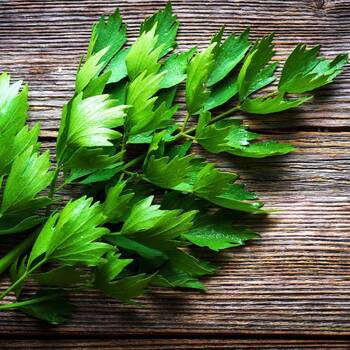
How to Grow Lovage Seeds
Grow Guide #2394
Family: Apiaceae
Binomial name: Levisticum officinale
Life Cycle: Perennial
This 'How to Grow' guide details everything a home gardener needs to know to plant, grow and care for Lovage (Levisticum officinale).
When to Sow Lovage Seeds
Lovage is a perennial plant that grows year round in most climates. Use the table below to identify the best time of year to sow lovage seeds in your climate.
| JAN | FEB | MAR | APR | MAY | JUN | JUL | AUG | SEP | OCT | NOV | DEC | |
|---|---|---|---|---|---|---|---|---|---|---|---|---|
| Cool | ||||||||||||
| Temperate | ||||||||||||
| Sub-Tropical | ||||||||||||
| Tropical | ||||||||||||
| Arid |
Preparation
Lovage plants are best grown in full sun or part shade. Choose a location that will receive at least 3 hours of full sun each day.
Lovage plants need a well drained soil enriched with plenty of organic matter. Prepare soil by weeding it thoroughly, digging it over to loosen it and adding aged animal manure or compost. Keep the area free of weeds until planting. Learn more about preparing soil for planting here.
Lovage plants can be grown in containers. If possible choose a variety that’s recommended for container growing. Use a good quality potting mix and make sure your container is large enough for mature plants; a minimum of 40 litres is recommended for lovage. During the growing season, keep in mind that container grown plants may need additional fertiliser to encourage healthy growth.
How to Sow Lovage Seeds
Lovage seeds do not require any treatment (eg soaking, stratification) before sowing.
Lovage seeds can be sown directly into the garden OR seedlings can be raised in trays or other containers and transplanted to the garden once established.
Sow Direct
- Sow seeds directly in the garden 6mm deep and 100cm apart.
- Keep soil moist but never wet or dry.
- Seeds should germinate in around 7-21 days at a soil temperature of 20-25°C.
- Young seedlings will need protection from pests, pets and weather until they are established.
Raise Seedlings
- Fill trays, punnets or jiffy pots with a good quality seed-raising mix, or use soil starter pellets.
- Sow seeds 6mm deep.
- Keep soil moist but never wet or dry.
- Seeds should germinate in around 7-21 days at a soil temperature of 20-25°C.
- Transplant seedlings to the garden once they have their first true leaves and are large enough to handle (usually 5-10cm tall).
- Plant out, spacing plants 100cm apart.
Tip: Lovage seeds can also be sown in the less formal ‘scatter seed’ method. Simply roughen the soil, scatter seeds evenly over the surface, then smooth the soil over lightly to cover the seeds.
How to Grow Lovage
Lovage plants may need watering during the growing season. Water when the soil is dry about 5cm below the surface (test this by scratching away a little soil with your finger). Water deeply in the early morning or late afternoon. Avoid watering the leaves of plants to avoid fungal diseases. Learn more about watering here.
If soil was well prepared no extra fertiliser should be necessary. In poor soil or to give your plants an extra boost, application of a balanced fertiliser or one formulated for fruit and vegetables can be beneficial:
- Apply slow release fertiliser at the recommended rate when transplanting or when seedlings are 5-10cm tall.
- Apply liquid fertiliser at the recommended rate and frequency while plants are fruiting or flowering.
Optional: To give plants room to grow, thin seedlings when they are large enough to handle. Pull out any weak or small seedlings so plants are spaced about 100cm apart.
If growing lovage for its leaves, harvest regularly to encourage new leaf growth. If growing lovage for its seeds, allow the plant to flower and set seed.
Lovage plants may die back in cold weather. Cut plants back just above ground level in late autumn, or prune off dead foliage when new leaves emerge in spring.
How to Harvest Lovage
Lovage should be ready to harvest in approximately 90 days.
Leaves are ready to harvest when they are large enough to eat, and can be harvested as needed. Harvest leaves by pinching off the outer leaves, leaving some on the plant for future growth.
Seed is ready to harvest when seed heads begin to turn brown. Place whole seed heads in a paper bag and hang upside down in a dry airy place until the seeds are dry.
Common Problems when Growing Lovage
Like all plants, lovage is susceptible to some pests, diseases and other problems. Below is a list of the most common problems gardeners encounter when growing lovage plants:
 Slugs and snails are molluscs that feed on tender leaves and shoots, mostly at night, leaving slimy trails behind them. Control them by removing their hiding places, keeping free range poultry, collecting them by torchlight or by placing traps. Read more about slugs and snails here.
Slugs and snails are molluscs that feed on tender leaves and shoots, mostly at night, leaving slimy trails behind them. Control them by removing their hiding places, keeping free range poultry, collecting them by torchlight or by placing traps. Read more about slugs and snails here.


.png)



